Report on Climate Change and Climate Action Policies in Afghanistan
VerifiedAdded on 2022/09/26
|5
|1191
|23
Report
AI Summary
This report provides an overview of climate change and climate action in Afghanistan, focusing on the country's domestic policies. It examines the governance structure, including the National Climate Change Committee, and outlines key policies in the power sector, social protection, and environmental protection. The report highlights strategies such as increasing renewable energy sources, promoting reforestation, and integrating climate change into national planning. It also details training programs for relevant ministries and farmers to address climate risks. The conclusion emphasizes the importance of mitigation, prevention, and awareness programs in Afghanistan's approach to climate change, including the significance of importing environmentally friendly energy sources and reforestation initiatives. The report is based on the assignment brief that discusses the importance of climate action and its impact on sustainable development.
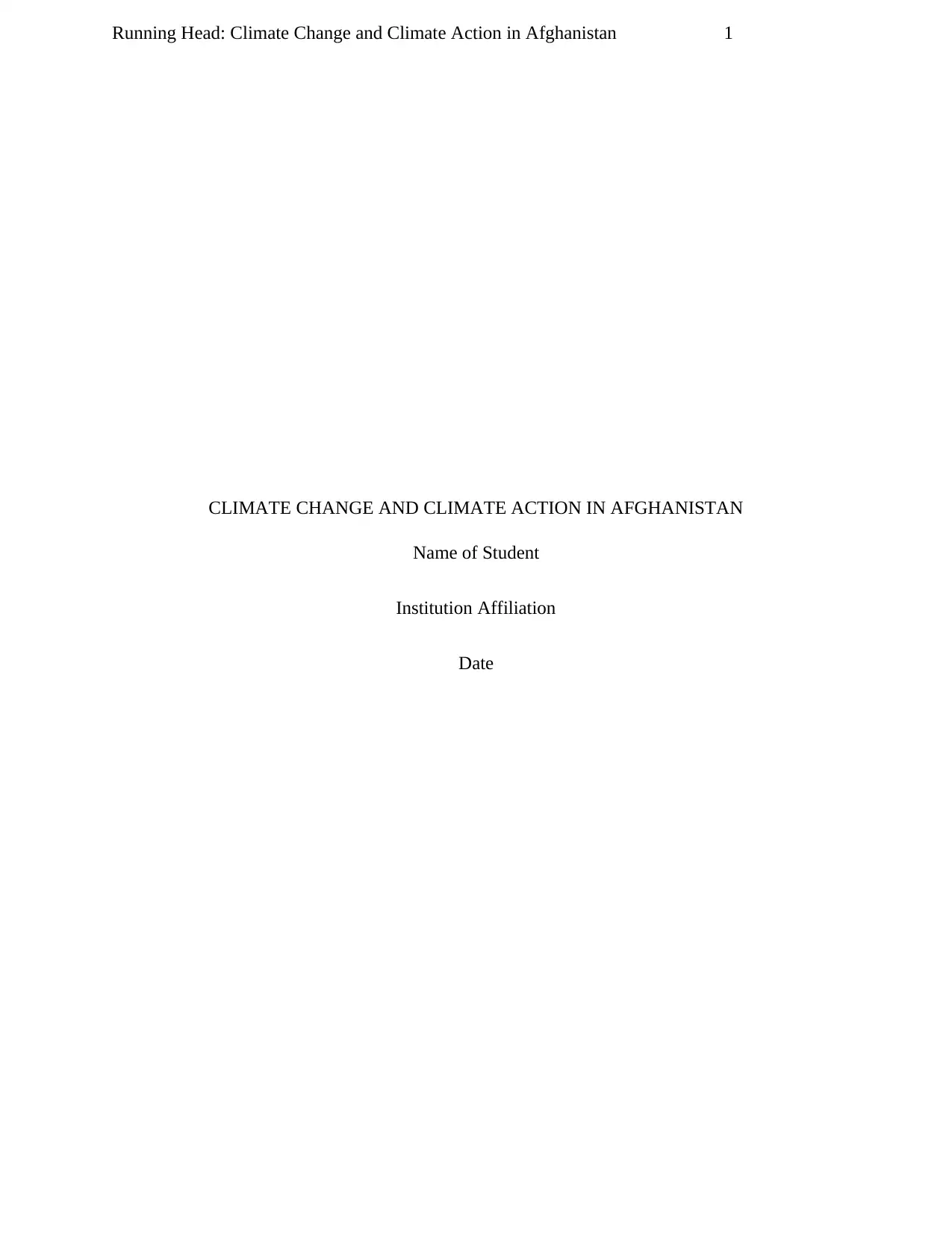
Running Head: Climate Change and Climate Action in Afghanistan 1
CLIMATE CHANGE AND CLIMATE ACTION IN AFGHANISTAN
Name of Student
Institution Affiliation
Date
CLIMATE CHANGE AND CLIMATE ACTION IN AFGHANISTAN
Name of Student
Institution Affiliation
Date
Paraphrase This Document
Need a fresh take? Get an instant paraphrase of this document with our AI Paraphraser
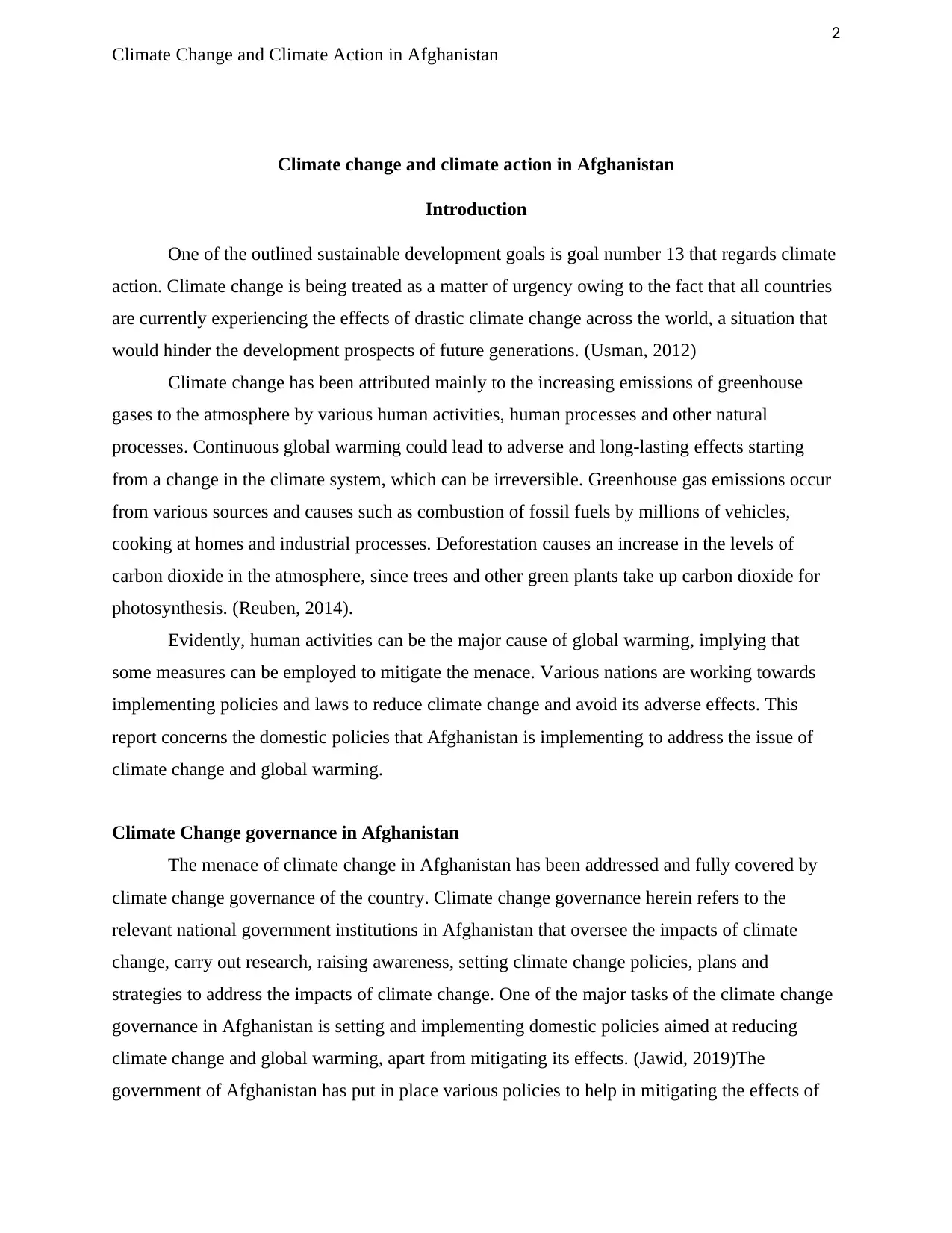
2
Climate Change and Climate Action in Afghanistan
Climate change and climate action in Afghanistan
Introduction
One of the outlined sustainable development goals is goal number 13 that regards climate
action. Climate change is being treated as a matter of urgency owing to the fact that all countries
are currently experiencing the effects of drastic climate change across the world, a situation that
would hinder the development prospects of future generations. (Usman, 2012)
Climate change has been attributed mainly to the increasing emissions of greenhouse
gases to the atmosphere by various human activities, human processes and other natural
processes. Continuous global warming could lead to adverse and long-lasting effects starting
from a change in the climate system, which can be irreversible. Greenhouse gas emissions occur
from various sources and causes such as combustion of fossil fuels by millions of vehicles,
cooking at homes and industrial processes. Deforestation causes an increase in the levels of
carbon dioxide in the atmosphere, since trees and other green plants take up carbon dioxide for
photosynthesis. (Reuben, 2014).
Evidently, human activities can be the major cause of global warming, implying that
some measures can be employed to mitigate the menace. Various nations are working towards
implementing policies and laws to reduce climate change and avoid its adverse effects. This
report concerns the domestic policies that Afghanistan is implementing to address the issue of
climate change and global warming.
Climate Change governance in Afghanistan
The menace of climate change in Afghanistan has been addressed and fully covered by
climate change governance of the country. Climate change governance herein refers to the
relevant national government institutions in Afghanistan that oversee the impacts of climate
change, carry out research, raising awareness, setting climate change policies, plans and
strategies to address the impacts of climate change. One of the major tasks of the climate change
governance in Afghanistan is setting and implementing domestic policies aimed at reducing
climate change and global warming, apart from mitigating its effects. (Jawid, 2019)The
government of Afghanistan has put in place various policies to help in mitigating the effects of
Climate Change and Climate Action in Afghanistan
Climate change and climate action in Afghanistan
Introduction
One of the outlined sustainable development goals is goal number 13 that regards climate
action. Climate change is being treated as a matter of urgency owing to the fact that all countries
are currently experiencing the effects of drastic climate change across the world, a situation that
would hinder the development prospects of future generations. (Usman, 2012)
Climate change has been attributed mainly to the increasing emissions of greenhouse
gases to the atmosphere by various human activities, human processes and other natural
processes. Continuous global warming could lead to adverse and long-lasting effects starting
from a change in the climate system, which can be irreversible. Greenhouse gas emissions occur
from various sources and causes such as combustion of fossil fuels by millions of vehicles,
cooking at homes and industrial processes. Deforestation causes an increase in the levels of
carbon dioxide in the atmosphere, since trees and other green plants take up carbon dioxide for
photosynthesis. (Reuben, 2014).
Evidently, human activities can be the major cause of global warming, implying that
some measures can be employed to mitigate the menace. Various nations are working towards
implementing policies and laws to reduce climate change and avoid its adverse effects. This
report concerns the domestic policies that Afghanistan is implementing to address the issue of
climate change and global warming.
Climate Change governance in Afghanistan
The menace of climate change in Afghanistan has been addressed and fully covered by
climate change governance of the country. Climate change governance herein refers to the
relevant national government institutions in Afghanistan that oversee the impacts of climate
change, carry out research, raising awareness, setting climate change policies, plans and
strategies to address the impacts of climate change. One of the major tasks of the climate change
governance in Afghanistan is setting and implementing domestic policies aimed at reducing
climate change and global warming, apart from mitigating its effects. (Jawid, 2019)The
government of Afghanistan has put in place various policies to help in mitigating the effects of
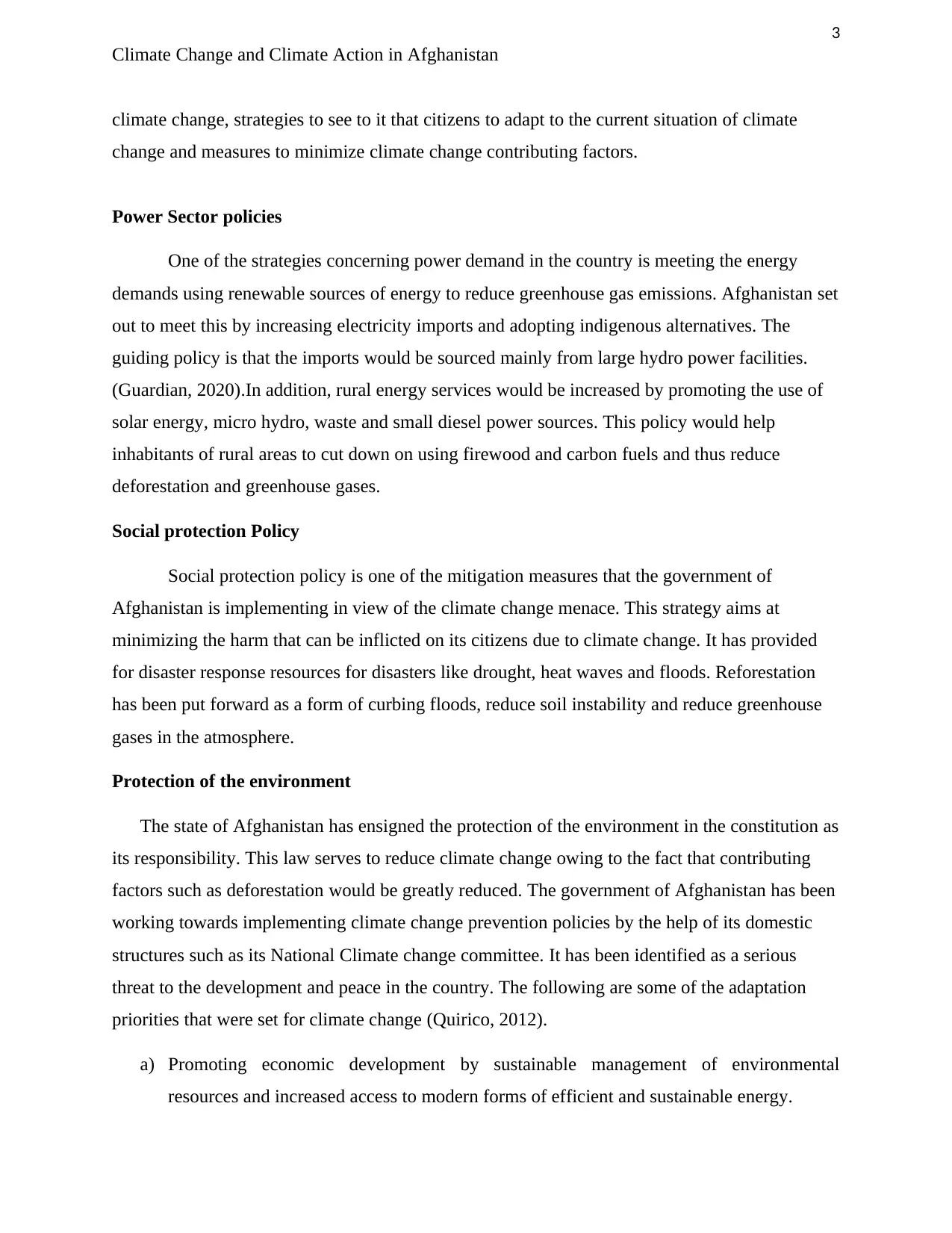
3
Climate Change and Climate Action in Afghanistan
climate change, strategies to see to it that citizens to adapt to the current situation of climate
change and measures to minimize climate change contributing factors.
Power Sector policies
One of the strategies concerning power demand in the country is meeting the energy
demands using renewable sources of energy to reduce greenhouse gas emissions. Afghanistan set
out to meet this by increasing electricity imports and adopting indigenous alternatives. The
guiding policy is that the imports would be sourced mainly from large hydro power facilities.
(Guardian, 2020).In addition, rural energy services would be increased by promoting the use of
solar energy, micro hydro, waste and small diesel power sources. This policy would help
inhabitants of rural areas to cut down on using firewood and carbon fuels and thus reduce
deforestation and greenhouse gases.
Social protection Policy
Social protection policy is one of the mitigation measures that the government of
Afghanistan is implementing in view of the climate change menace. This strategy aims at
minimizing the harm that can be inflicted on its citizens due to climate change. It has provided
for disaster response resources for disasters like drought, heat waves and floods. Reforestation
has been put forward as a form of curbing floods, reduce soil instability and reduce greenhouse
gases in the atmosphere.
Protection of the environment
The state of Afghanistan has ensigned the protection of the environment in the constitution as
its responsibility. This law serves to reduce climate change owing to the fact that contributing
factors such as deforestation would be greatly reduced. The government of Afghanistan has been
working towards implementing climate change prevention policies by the help of its domestic
structures such as its National Climate change committee. It has been identified as a serious
threat to the development and peace in the country. The following are some of the adaptation
priorities that were set for climate change (Quirico, 2012).
a) Promoting economic development by sustainable management of environmental
resources and increased access to modern forms of efficient and sustainable energy.
Climate Change and Climate Action in Afghanistan
climate change, strategies to see to it that citizens to adapt to the current situation of climate
change and measures to minimize climate change contributing factors.
Power Sector policies
One of the strategies concerning power demand in the country is meeting the energy
demands using renewable sources of energy to reduce greenhouse gas emissions. Afghanistan set
out to meet this by increasing electricity imports and adopting indigenous alternatives. The
guiding policy is that the imports would be sourced mainly from large hydro power facilities.
(Guardian, 2020).In addition, rural energy services would be increased by promoting the use of
solar energy, micro hydro, waste and small diesel power sources. This policy would help
inhabitants of rural areas to cut down on using firewood and carbon fuels and thus reduce
deforestation and greenhouse gases.
Social protection Policy
Social protection policy is one of the mitigation measures that the government of
Afghanistan is implementing in view of the climate change menace. This strategy aims at
minimizing the harm that can be inflicted on its citizens due to climate change. It has provided
for disaster response resources for disasters like drought, heat waves and floods. Reforestation
has been put forward as a form of curbing floods, reduce soil instability and reduce greenhouse
gases in the atmosphere.
Protection of the environment
The state of Afghanistan has ensigned the protection of the environment in the constitution as
its responsibility. This law serves to reduce climate change owing to the fact that contributing
factors such as deforestation would be greatly reduced. The government of Afghanistan has been
working towards implementing climate change prevention policies by the help of its domestic
structures such as its National Climate change committee. It has been identified as a serious
threat to the development and peace in the country. The following are some of the adaptation
priorities that were set for climate change (Quirico, 2012).
a) Promoting economic development by sustainable management of environmental
resources and increased access to modern forms of efficient and sustainable energy.
⊘ This is a preview!⊘
Do you want full access?
Subscribe today to unlock all pages.

Trusted by 1+ million students worldwide
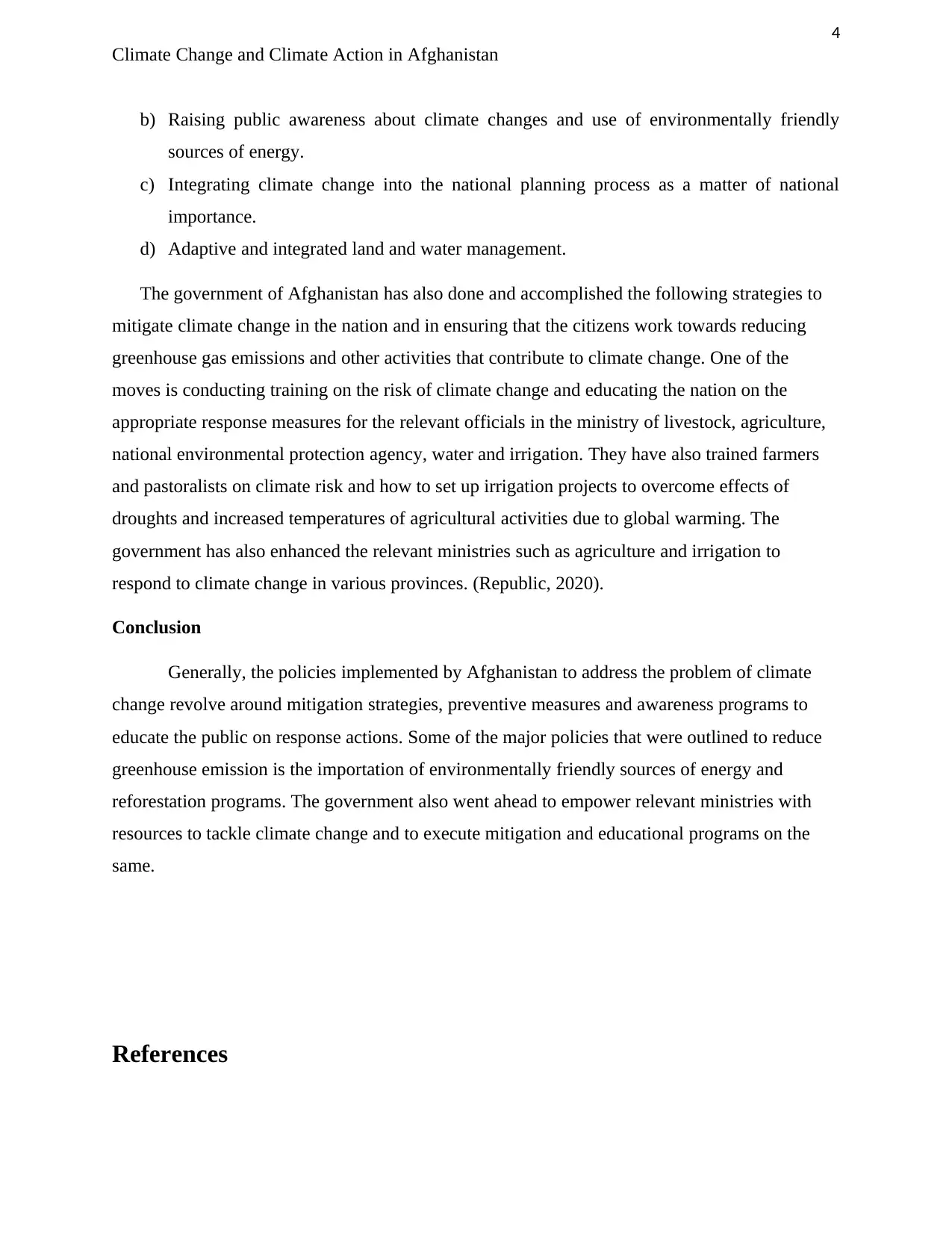
4
Climate Change and Climate Action in Afghanistan
b) Raising public awareness about climate changes and use of environmentally friendly
sources of energy.
c) Integrating climate change into the national planning process as a matter of national
importance.
d) Adaptive and integrated land and water management.
The government of Afghanistan has also done and accomplished the following strategies to
mitigate climate change in the nation and in ensuring that the citizens work towards reducing
greenhouse gas emissions and other activities that contribute to climate change. One of the
moves is conducting training on the risk of climate change and educating the nation on the
appropriate response measures for the relevant officials in the ministry of livestock, agriculture,
national environmental protection agency, water and irrigation. They have also trained farmers
and pastoralists on climate risk and how to set up irrigation projects to overcome effects of
droughts and increased temperatures of agricultural activities due to global warming. The
government has also enhanced the relevant ministries such as agriculture and irrigation to
respond to climate change in various provinces. (Republic, 2020).
Conclusion
Generally, the policies implemented by Afghanistan to address the problem of climate
change revolve around mitigation strategies, preventive measures and awareness programs to
educate the public on response actions. Some of the major policies that were outlined to reduce
greenhouse emission is the importation of environmentally friendly sources of energy and
reforestation programs. The government also went ahead to empower relevant ministries with
resources to tackle climate change and to execute mitigation and educational programs on the
same.
References
Climate Change and Climate Action in Afghanistan
b) Raising public awareness about climate changes and use of environmentally friendly
sources of energy.
c) Integrating climate change into the national planning process as a matter of national
importance.
d) Adaptive and integrated land and water management.
The government of Afghanistan has also done and accomplished the following strategies to
mitigate climate change in the nation and in ensuring that the citizens work towards reducing
greenhouse gas emissions and other activities that contribute to climate change. One of the
moves is conducting training on the risk of climate change and educating the nation on the
appropriate response measures for the relevant officials in the ministry of livestock, agriculture,
national environmental protection agency, water and irrigation. They have also trained farmers
and pastoralists on climate risk and how to set up irrigation projects to overcome effects of
droughts and increased temperatures of agricultural activities due to global warming. The
government has also enhanced the relevant ministries such as agriculture and irrigation to
respond to climate change in various provinces. (Republic, 2020).
Conclusion
Generally, the policies implemented by Afghanistan to address the problem of climate
change revolve around mitigation strategies, preventive measures and awareness programs to
educate the public on response actions. Some of the major policies that were outlined to reduce
greenhouse emission is the importation of environmentally friendly sources of energy and
reforestation programs. The government also went ahead to empower relevant ministries with
resources to tackle climate change and to execute mitigation and educational programs on the
same.
References
Paraphrase This Document
Need a fresh take? Get an instant paraphrase of this document with our AI Paraphraser
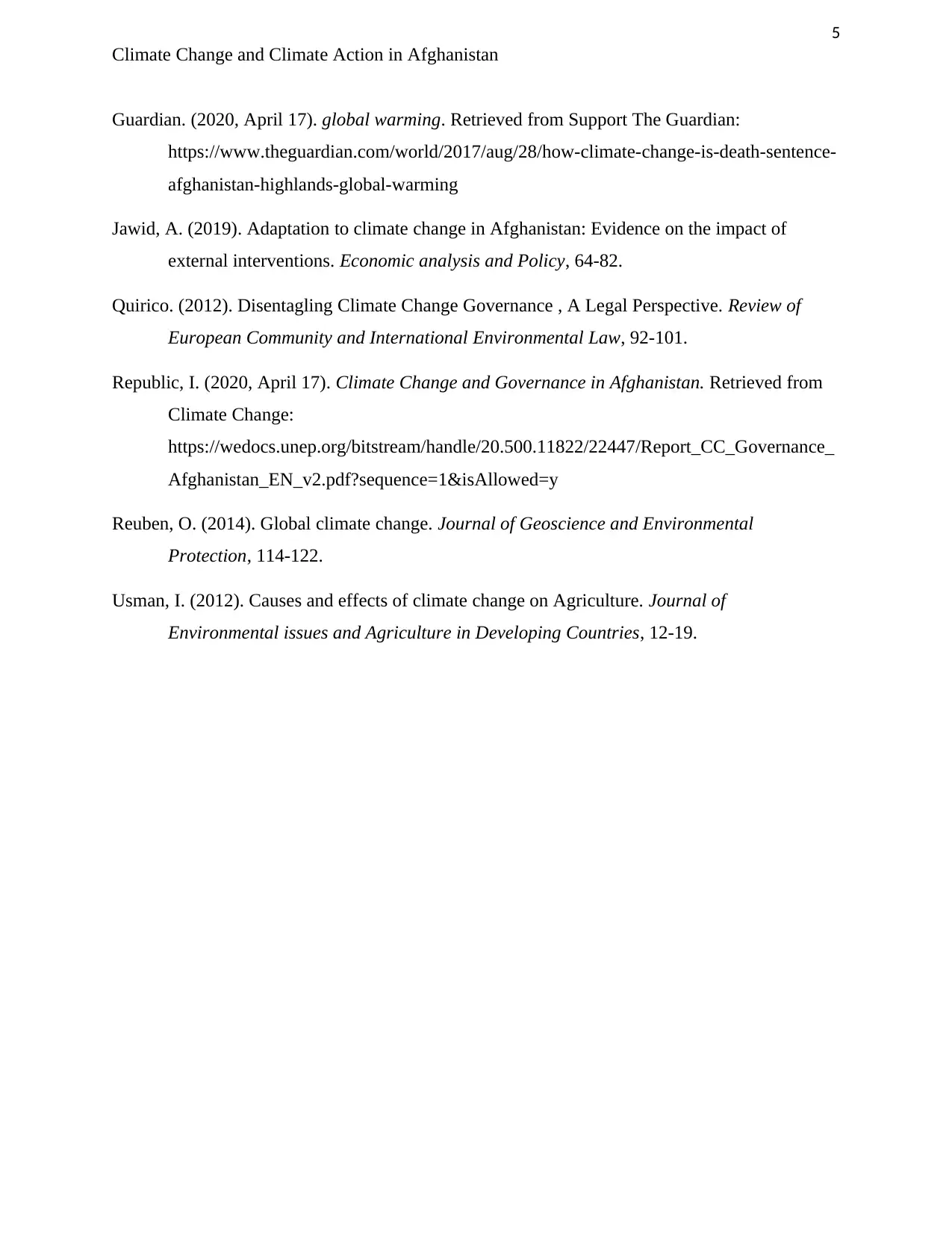
5
Climate Change and Climate Action in Afghanistan
Guardian. (2020, April 17). global warming. Retrieved from Support The Guardian:
https://www.theguardian.com/world/2017/aug/28/how-climate-change-is-death-sentence-
afghanistan-highlands-global-warming
Jawid, A. (2019). Adaptation to climate change in Afghanistan: Evidence on the impact of
external interventions. Economic analysis and Policy, 64-82.
Quirico. (2012). Disentagling Climate Change Governance , A Legal Perspective. Review of
European Community and International Environmental Law, 92-101.
Republic, I. (2020, April 17). Climate Change and Governance in Afghanistan. Retrieved from
Climate Change:
https://wedocs.unep.org/bitstream/handle/20.500.11822/22447/Report_CC_Governance_
Afghanistan_EN_v2.pdf?sequence=1&isAllowed=y
Reuben, O. (2014). Global climate change. Journal of Geoscience and Environmental
Protection, 114-122.
Usman, I. (2012). Causes and effects of climate change on Agriculture. Journal of
Environmental issues and Agriculture in Developing Countries, 12-19.
Climate Change and Climate Action in Afghanistan
Guardian. (2020, April 17). global warming. Retrieved from Support The Guardian:
https://www.theguardian.com/world/2017/aug/28/how-climate-change-is-death-sentence-
afghanistan-highlands-global-warming
Jawid, A. (2019). Adaptation to climate change in Afghanistan: Evidence on the impact of
external interventions. Economic analysis and Policy, 64-82.
Quirico. (2012). Disentagling Climate Change Governance , A Legal Perspective. Review of
European Community and International Environmental Law, 92-101.
Republic, I. (2020, April 17). Climate Change and Governance in Afghanistan. Retrieved from
Climate Change:
https://wedocs.unep.org/bitstream/handle/20.500.11822/22447/Report_CC_Governance_
Afghanistan_EN_v2.pdf?sequence=1&isAllowed=y
Reuben, O. (2014). Global climate change. Journal of Geoscience and Environmental
Protection, 114-122.
Usman, I. (2012). Causes and effects of climate change on Agriculture. Journal of
Environmental issues and Agriculture in Developing Countries, 12-19.
1 out of 5
Related Documents
Your All-in-One AI-Powered Toolkit for Academic Success.
+13062052269
info@desklib.com
Available 24*7 on WhatsApp / Email
![[object Object]](/_next/static/media/star-bottom.7253800d.svg)
Unlock your academic potential
Copyright © 2020–2025 A2Z Services. All Rights Reserved. Developed and managed by ZUCOL.



